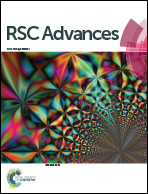Controlled fabrication of polymeric Janus nanoparticles and their solution behaviors†
Abstract
Well-defined polymeric Janus nanoparticles of different morphologies have been achieved by step-wise self-assembly procedures of simple ABC linear tri-block terpolymers, with Janus balances adjustable simply by regulating the chain length of the hydrophilic block. The influences of Janus balance have been investigated on the solution behaviors of the prepared Janus nanoparticles.


 Please wait while we load your content...
Please wait while we load your content...